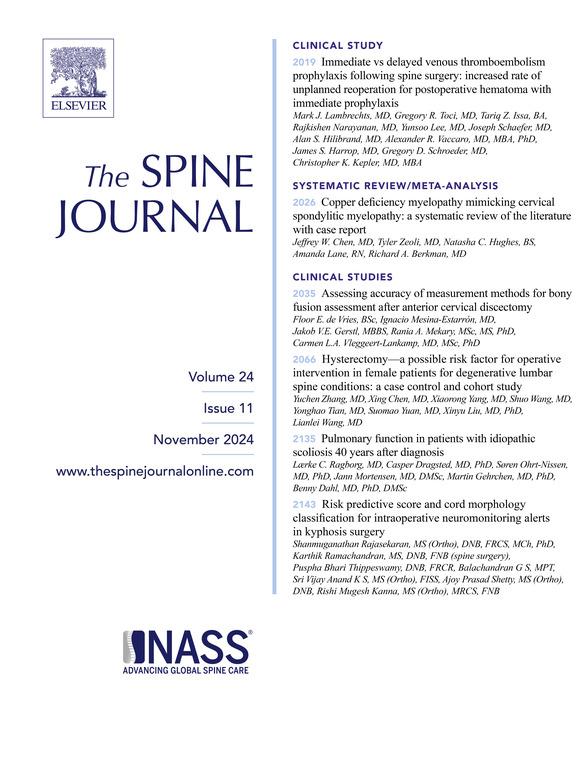63. Rutin attenuates distraction spinal cord injury by inhibiting microglial inflammation through downregulation of P38 MAPK/NF-?B/STAT3 pathway
IF 4.7
1区 医学
Q1 CLINICAL NEUROLOGY
引用次数: 0
Abstract
BACKGROUND CONTEXT
Distraction spinal cord injury (DSCI) is a severe complication following scoliosis correction surgery, for which there are currently no effective clinical treatments.
PURPOSE
This study aims to evaluate the inhibitory effects of rutin, a natural product, on inflammation in DSCI and to investigate the underlying mechanisms.
STUDY DESIGN/SETTING
This study employed a combination of in vitro and in vivo experimental designs to investigate the anti-inflammatory and neuroprotective effects of rutin in the context of DSCI. The in vitro component utilized a cell culture model to assess the direct effects of rutin on LPS-induced inflammation in microglial cells. The in vivo component involved a randomized controlled animal model of DSCI to evaluate the therapeutic potential of rutin. Molecular studies, including mRNA sequencing, KEGG pathway analysis, and molecular docking, were conducted to elucidate the underlying mechanisms of rutin's action. The study design ensured a comprehensive approach to understanding the role of rutin in mitigating inflammation and promoting recovery following spinal cord injury.
PATIENT SAMPLE
N/A
OUTCOME MEASURES
N/A
METHODS
In Vitro Studies: Microglial cells were cultured in Dulbecco's Modified Eagle Medium (DMEM) supplemented with 10% fetal bovine serum (FBS) and 1% penicillin-streptomycin at 37°C in a humidified atmosphere containing 5% CO2. Cells were seeded in 6-well plates at a density of 1 × 10^6 cells per well and allowed to adhere overnight. To induce inflammation, cells were treated with 1 µg/mL lipopolysaccharide (LPS) for 24 hours. Concurrently, cells were exposed to varying concentrations of rutin (10 µM, 20 µM, and 50 µM) to assess its anti-inflammatory effects. After treatment, cell supernatants were collected, and the levels of inflammatory cytokines (TNF-α, IL-1β, and IL-6) were measured using enzyme-linked immunosorbent assays (ELISA). Cell viability was assessed using the MTT assay to ensure that rutin concentrations used did not induce cytotoxicity. In Vivo Studies: Adult male Sprague-Dawley rats (weight 250-300 g) were used for the dorsal spinal cord injury (DSCI) model. Rats were anesthetized with intraperitoneal injections of ketamine (80 mg/kg) and xylazine (10 mg/kg). A laminectomy was performed at the T10 vertebral level, and the dorsal spinal cord was exposed. DSCI was induced using a weight-drop impactor (10 g weight dropped from a height of 25 mm). Post-surgery, rats were randomly divided into three groups: sham-operated (control), DSCI + vehicle (saline), and DSCI + rutin (50 mg/kg/day, intraperitoneal injection). Behavioral assessments were conducted using the Basso-Beattie-Bresnahan (BBB) locomotor rating scale at 1, 3, 7, 14, and 21 days postinjury. Rats were sacrificed at 21 days postinjury, and spinal cord tissues were harvested for further analysis. Molecular Studies: Total RNA was extracted from spinal cord tissues using TRIzol reagent, and mRNA sequencing was performed using the Illumina HiSeq 4000 platform. Differentially expressed genes (DEGs) were identified using the DESeq2 package in R, with a threshold of |log2 fold change| > 1 and adjusted p-value < 0.05. Functional enrichment analysis of DEGs was conducted using the Kyoto Encyclopedia of Genes and Genomes (KEGG) pathway database. The top DEGs were validated using reverse transcription-quantitative polymerase chain reaction (RT-qPCR). Molecular docking studies were performed to investigate the interaction between rutin and P38 MAPK using AutoDock Vina. The crystal structure of P38 MAPK (PDB ID: 1P38) was obtained from the Protein Data Bank, and the binding affinity was calculated.
RESULTS
In vitro, microglial cells were exposed directly to rutin to assess its ability to inhibit lipopolysaccharide (LPS)-induced inflammation. In rats with DSCI, the inhibitory effect of rutin on DSCI was evaluated using behavioral tests. mRNA sequencing was performed on spinal cord tissues to elucidate the mechanism of rutin's action. Rutin significantly suppressed the LPS-induced increase in inflammatory factors in microglial cells. In DSCI rats treated with rutin, scores in the Basso-Beattie-Bresnahan (BBB) were significantly improved. The mechanism of rutin's action was found to be related to its ability to reduce inflammatory infiltration in spinal cord tissue, protecting neurons from apoptosis and microstructural demyelination. Through assays of transcriptomic differentially expressed genes (DEGs), Kyoto Encyclopedia of Genes and Genomes (KEGG) pathway analysis, and RT-qPCR validation of the top DEGs, MAPK13 (also known as P38 MAPK) was finally identified as the key target gene in promoting DSCI development. Further molecular docking analysis indicated an interaction between rutin and P38 MAPK, supporting the rutin's action and the underlying mechanism in anti-inflammation.
CONCLUSIONS
In conclusion, rutin effectively inhibited the development of DSCI in rats. The mechanism of rutin's action was associated with its activity in blocking the P38 MAPK/NF-κB/STAT3 pathway in the microglial cells of spinal cord. Rutin could be developed as a potential anti-DSCI drug for clinical applications.
FDA Device/Drug Status
Rutin (Approved for this indication)
63. 芦丁通过下调P38 MAPK/NF-?抑制小胶质细胞炎症减轻牵张性脊髓损伤B / STAT3通路
背景背景牵张性脊髓损伤(DSCI)是脊柱侧凸矫正手术后的严重并发症,目前尚无有效的临床治疗方法。目的评价天然产物芦丁对DSCI炎症的抑制作用,并探讨其作用机制。研究设计/背景本研究采用体外和体内相结合的实验设计来研究芦丁在DSCI中的抗炎和神经保护作用。体外成分利用细胞培养模型评估芦丁对lps诱导的小胶质细胞炎症的直接影响。体内成分涉及DSCI的随机对照动物模型,以评估芦丁的治疗潜力。通过mRNA测序、KEGG通路分析和分子对接等分子研究来阐明芦丁作用的潜在机制。研究设计确保了一个全面的方法来理解芦丁在减轻炎症和促进脊髓损伤后恢复中的作用。体外研究:小胶质细胞在添加10%胎牛血清(FBS)和1%青霉素-链霉素的Dulbecco's Modified Eagle培养基(DMEM)中培养,37℃,含5% CO2的湿化气氛中培养。细胞以每孔1 × 10^6个细胞的密度接种于6孔板中,并粘附过夜。以1µg/mL脂多糖(LPS)处理细胞24小时诱导炎症反应。同时,细胞暴露于不同浓度的芦丁(10µM, 20µM和50µM)以评估其抗炎作用。处理后收集细胞上清液,采用酶联免疫吸附法(ELISA)检测炎症因子(TNF-α、IL-1β和IL-6)水平。使用MTT法评估细胞活力,以确保使用的芦丁浓度不会诱导细胞毒性。体内实验:采用成年雄性Sprague-Dawley大鼠(体重250-300 g)建立背脊髓损伤(DSCI)模型。大鼠腹腔注射氯胺酮(80 mg/kg)和噻嗪(10 mg/kg)麻醉。在T10椎体水平行椎板切除术,暴露脊髓背侧。使用减重冲击器(从25mm高度落下10g重量)诱导DSCI。术后将大鼠随机分为假手术组(对照组)、DSCI + 载药组(生理盐水)、DSCI + 芦丁组(50 mg/kg/天,腹腔注射)。在损伤后1、3、7、14和21天,使用Basso-Beattie-Bresnahan (BBB)运动量表进行行为评估。损伤后21天处死大鼠,收集脊髓组织作进一步分析。分子研究:使用TRIzol试剂从脊髓组织中提取总RNA,使用Illumina HiSeq 4000平台进行mRNA测序。差异表达基因(DEGs)鉴定采用R中的DESeq2包,阈值为|log2倍变化| >; 1,调整p值<; 0.05。利用京都基因与基因组百科全书(KEGG)途径数据库对DEGs进行功能富集分析。使用逆转录-定量聚合酶链反应(RT-qPCR)验证了顶部的deg。利用AutoDock Vina进行分子对接研究,研究芦丁与P38 MAPK的相互作用。从Protein Data Bank中获取P38 MAPK (PDB ID: 1P38)的晶体结构,并计算其结合亲和力。结果在体外,将小胶质细胞直接暴露于芦丁,以评估其抑制脂多糖(LPS)诱导的炎症的能力。用行为学实验评价芦丁对DSCI大鼠的抑制作用。对脊髓组织进行mRNA测序,以阐明芦丁的作用机制。芦丁显著抑制lps诱导的小胶质细胞炎症因子的升高。芦丁治疗DSCI大鼠BBB评分明显改善。芦丁的作用机制与其减少脊髓组织炎症浸润、保护神经元免于细胞凋亡和微结构脱髓鞘的能力有关。通过转录组差异表达基因(DEGs)分析、京都基因与基因组百科全书(KEGG)通路分析以及顶端DEGs的RT-qPCR验证,最终确定MAPK13(又称P38 MAPK)是促进DSCI发展的关键靶基因。进一步的分子对接分析表明,芦丁与P38 MAPK之间存在相互作用,支持芦丁的抗炎作用及其潜在机制。结论芦丁能有效抑制大鼠DSCI的发生。 芦丁的作用机制与其阻断脊髓小胶质细胞P38 MAPK/NF-κB/STAT3通路的活性有关。芦丁具有开发抗脊髓损伤药物的潜力。FDA器械/药物状态芦丁(批准用于此适应症)
本文章由计算机程序翻译,如有差异,请以英文原文为准。
求助全文
约1分钟内获得全文
求助全文
来源期刊

Spine Journal
医学-临床神经学
CiteScore
8.20
自引率
6.70%
发文量
680
审稿时长
13.1 weeks
期刊介绍:
The Spine Journal, the official journal of the North American Spine Society, is an international and multidisciplinary journal that publishes original, peer-reviewed articles on research and treatment related to the spine and spine care, including basic science and clinical investigations. It is a condition of publication that manuscripts submitted to The Spine Journal have not been published, and will not be simultaneously submitted or published elsewhere. The Spine Journal also publishes major reviews of specific topics by acknowledged authorities, technical notes, teaching editorials, and other special features, Letters to the Editor-in-Chief are encouraged.
 求助内容:
求助内容: 应助结果提醒方式:
应助结果提醒方式:


